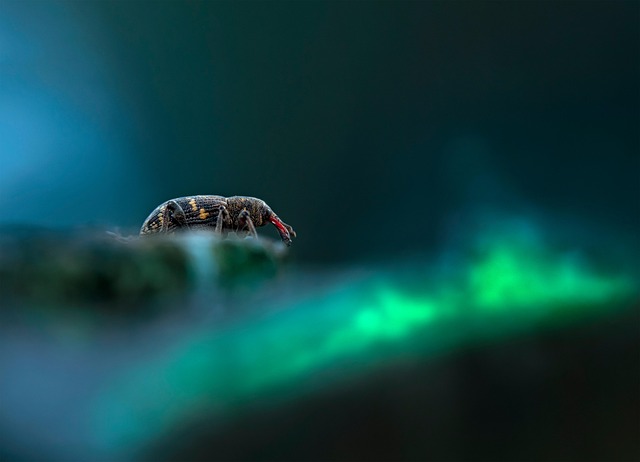Grain weevils, 1-3 mm household pests, infest stored grains and dried foods, causing damage. Effective grain weevil pest control requires understanding their habits and life cycles. For homes with children and pets, non-toxic methods like diatomaceous earth and lavender oil are safe alternatives to chemicals. Pet safety is crucial when managing grain weevils, using natural solutions like neem oil and thorough cleaning. Preventing infestations through hygiene, sanitation, and airtight storage is safer than eradication.
Grain weevils can cause significant damage to stored grains and feed, but controlling them safely around children and pets is essential. This comprehensive guide explores effective yet child- and pet-friendly methods for managing and preventing grain weevil infestations. From understanding these pests’ behavior to implementing practical strategies, learn how to protect your family and pets while safeguarding your pantry and livestock feeds. Discover safe, eco-conscious solutions for efficient grain weevil pest control.
Understanding Grain Weevils: Behavior and Impact
Grain weevils are a common household pest, particularly in areas where stored grains and dried foods are present. Understanding their behavior is crucial for effective grain weevil control. These tiny insects, often measuring just 1-3 mm in length, are drawn to starchy materials and can quickly infest pantries and food storage areas. They breed rapidly, with female weevils laying hundreds of eggs over their short lifespan, making early detection and intervention vital for prevention.
The impact of grain weevils extends beyond mere food contamination. As they feed on stored grains, they not only damage the quality but also introduce unsanitary conditions, posing potential health risks. Infestations can lead to the destruction of valuable food supplies and even cause structural damage to storage containers due to their boring behavior. Efficient grain weevil pest control requires a comprehensive understanding of these pests’ habits and life cycles to implement effective, child- and pet-safe strategies.
Child-Safe Approaches for Grain Weevil Control
When it comes to controlling grain weevils, especially in homes with children and pets, safety should be the top priority. There are several child-safe approaches that can effectively manage these pests without resorting to harmful chemicals. One of the most popular methods is using food-grade diatomaceous earth, a natural substance made from fossilized algae. It’s safe for use around kids and pets as it causes no skin or eye irritation and poses no toxicity risks when ingested. This powder acts by desiccating (drying out) the weevils, making it an environmentally friendly and non-toxic grain weevil pest control solution.
Another child-safe strategy involves employing natural repellents like cedar shavings or lavender essential oil. Cedar has a strong scent that weevils dislike, so placing cedar blocks in storage areas can help keep them away. Lavender oil, when diluted and sprayed around the house, can also act as a deterrent without any adverse effects on children or pets. These natural methods not only ensure the safety of your family but also promote a healthier living environment by avoiding exposure to synthetic chemicals.
Pet Safety Measures During Grain Weevil Management
When managing grain weevils, ensuring pet safety is paramount. Since many common pesticides can be harmful to both pets and humans, adopting child- and pet-safe methods for grain weevil control is essential. Opting for natural or organic solutions, such as neem oil or diatomaceous earth, can significantly reduce risks while effectively managing these pests.
During grain weevil management, keep in mind that pets, especially dogs and cats, may ingest treated grains or dust if they roam freely in affected areas. Therefore, isolating treatment zones, using pet-safe products, and thoroughly cleaning surfaces after application are crucial steps to safeguard your furry companions. Regular monitoring and quick response to any unusual behavior in pets post-treatment can also help ensure their well-being.
Effective Yet Safe Grain Weevil Prevention Techniques
When it comes to grain weevil pest control, preventing an infestation is always more effective and safer than eradicating one. The first line of defence should be implementing measures that deter these pests from ever entering your space. One surefire way is to maintain excellent hygiene practices, especially in areas where grains are stored. Regularly cleaning and sanitising these zones eliminates any food sources that might attract weevils.
Additionally, storing grains in airtight containers made of smooth, non-porous materials like glass or metal can significantly reduce the risk. Keep your pantry and food storage areas well-ventilated to deter these pests from being drawn in by moisture or odours. Remember, a little preventive care goes a long way in keeping grain weevils at bay, ensuring a safe environment for both children and pets.
When it comes to grain weevil pest control, prioritizing safety is paramount, especially in homes with children and pets. By adopting child- and pet-safe methods outlined in this article, such as regular cleaning, storage in airtight containers, and natural repellents like cedarwood or lavender oil, you can effectively manage these pests without putting your loved ones at risk. Combining these strategies with preventive techniques like proper ventilation and maintaining cleanliness creates a safe, pest-free environment for all.
